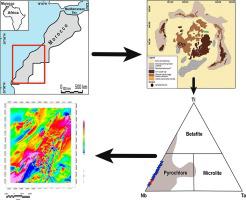Ore Geology Reviews ( IF 3.2 ) Pub Date : 2022-09-14 , DOI: 10.1016/j.oregeorev.2022.105105 Mohammed Bouabdellah , Wissale Boukirou , Michel Jébrak , Florent Bigot , Johan Yans , Abdellah Mouttaqi , Mohamed El Gadarri , Abdellatif Errami , Gilles Levresse

|
The Upper Cretaceous Twihinate carbonatite in Moroccan Sahara, which is the focus of ongoing exploration for Nb-P-Fe ± LREE ± U-Th resources, consists of a crescent-like intrusion made of a central sövite body encircled by an annular ring of vuggy siliceous breccia. Drill core logging coupled with petrographic observation, whole-rock and mineral chemistry reveal that the metasomatic interaction between the carbonatite melt and the silicate wall-rocks led to development of calc-silicate paragenesis within the sövite itself at depths ranging from ∼60 to >200 m from the surface for which the term antiskarn is attributed. We provide the first petrographic and textural descriptions, and report the whole-rock major- and trace-element geochemistry and chemical compositions of the main antiskarn-forming minerals and related strategic metal-bearing ore. Geochemically, the antiskarn lithotypes are characterized by a compositional range of 7–17 wt% SiO2, 25–72 wt% CaO, 1–2 wt% Al2O3, and 12–26 wt% loss on ignition, and enrichment in large-ion lithophile elements (LILE), particularly Sr (3125–7018 ppm ppm), Ba (393–1300 ppm), U (10–787 ppm) and light REEs (LREEs) (1058–1569 ppm), but not in the heavy REE (HREEs) and high-field strength elements (HFSE) such as Ti, Zr, Ta and Hf. Nb and V show, however, much higher concentrations ranging from 140 ppm to >1000 ppm, and 603 to 1008 ppm, respectively. Mineralogically, the antiskarn lithotypes consist predominantly of diopsidic (Di66-82 Hd18-34) to aegirine-augite clinopyroxene (Di38-55 Ae21-35) and andradite (And86-94 Gro1-9) with subordinate amounts of micas (biotite/phlogopite) and titanite. The paragenetically later mineral assemblages involve amphibole, chlorite, epidotes, baryte, fluorite, kaolinite, carbonates and quartz. The main Nb-P-Fe ± LREE ± U-Th ore minerals consist of Fe oxides (titanomagnetite principally), pyrochlore group minerals, phosphates (apatite, monazite-(Ce)), and REE-fluorcarbonates (bastnäsite-(Ce)) with subordinate sulfides (chalcopyrite, sphalerite, and galena), fluorite and baryte. Development of the antiskarn calc-silicate paragenesis and related strategic metal-bearing mineralization is consistent with derivation from a carbonatite melt through assimilation of silicate country rocks including the Silurian-Devonian gneissic granitoid of the Laknouk suite. From an economic perspective, the widespread occurrence of high-Ti (0.7–16. 9 wt% Ti) and V- (0.2–0.7 wt% V) magnetite opens new opportunities in regard of exploration for V; an emerging strategic commodity whose presence has to be reassessed in the Twihinate prospect. The currently described antiskarn paragenesis may be therefore used as reliable exploration metallotect to target prospective occurrences in the search for critical metals including V as by product.
中文翻译:

在上白垩统 Twihinate 碳酸盐岩侵入体(西非克拉通边缘,摩洛哥撒哈拉沙漠)中发现了以反卡岩为主体的战略金属矿化
摩洛哥撒哈拉的上白垩统 Twihinate 碳酸盐岩是正在进行的 Nb-P-Fe ± LREE ± U-Th 资源勘探的重点,由一个新月状侵入体组成,该侵入体由一个中央 sövite 体组成,周围环绕着一个环形的孔洞硅质角砾岩。钻芯测井与岩石学观察、全岩和矿物化学相结合,揭示了碳酸岩熔体与硅酸盐围岩之间的交代相互作用导致在 60 到 >200 深度范围内的 sövite 内部发生了钙硅酸盐共生。 m 来自术语 antiskarn 的表面。我们提供了第一个岩石学和纹理描述,并报告了主要反矽卡岩形成矿物和相关战略含金属矿石的全岩主要和微量元素地球化学和化学成分。2、25-72 wt% CaO、1-2 wt% Al 2 O 3和 12-26 wt% 烧失量,以及大离子亲石元素 (LILE) 的富集,特别是 Sr (3125-7018 ppm ppm) , Ba (393–1300 ppm), U (10–787 ppm) 和轻稀土元素 (LREEs) (1058–1569 ppm),但不在重稀土元素 (HREEs) 和高场强元素 (HFSE) 中,例如 Ti 、锆、钽和铪。然而,Nb 和 V 的浓度更高,分别为 140 ppm 至 >1000 ppm 和 603 至 1008 ppm。矿物学上,反斯卡岩岩型主要由透辉石 (Di 66-82 Hd 18-34 ) 到白云石-辉石单斜辉石 (Di 38 - 55 Ae 21-35 ) 和红辉石 (And 86-94 Gro1-9) 含有少量的云母(黑云母/金云母)和榍石。共生较晚的矿物组合包括闪石、绿泥石、绿帘石、重晶石、萤石、高岭石、碳酸盐和石英。主要 Nb-P-Fe ± LREE ± U-Th 矿石矿物由 Fe 氧化物(主要是钛磁铁矿)、烧绿石族矿物、磷酸盐(磷灰石、独居石-(Ce))和 REE-氟碳酸盐(氟碳铈矿-(Ce))组成与次要的硫化物(黄铜矿、闪锌矿和方铅矿)、萤石和重晶石。反矽岩钙硅酸盐共生和相关战略性含金属矿化的发展与通过硅酸盐围岩同化(包括 Laknouk 组的志留纪-泥盆纪片麻质花岗岩)的碳酸盐熔体的衍生相一致。从经济角度看,高钛(0.7-16. 9 wt% Ti) 和 V- (0.2–0.7 wt% V) 磁铁矿为 V 的勘探开辟了新机遇;一种新兴的战略商品,必须在 Twihinate 前景中重新评估其存在。因此,目前描述的反矽卡岩共生可用作可靠的勘探金属制剂,以在寻找包括 V 作为副产品在内的关键金属时瞄准预期的发生。











































 京公网安备 11010802027423号
京公网安备 11010802027423号